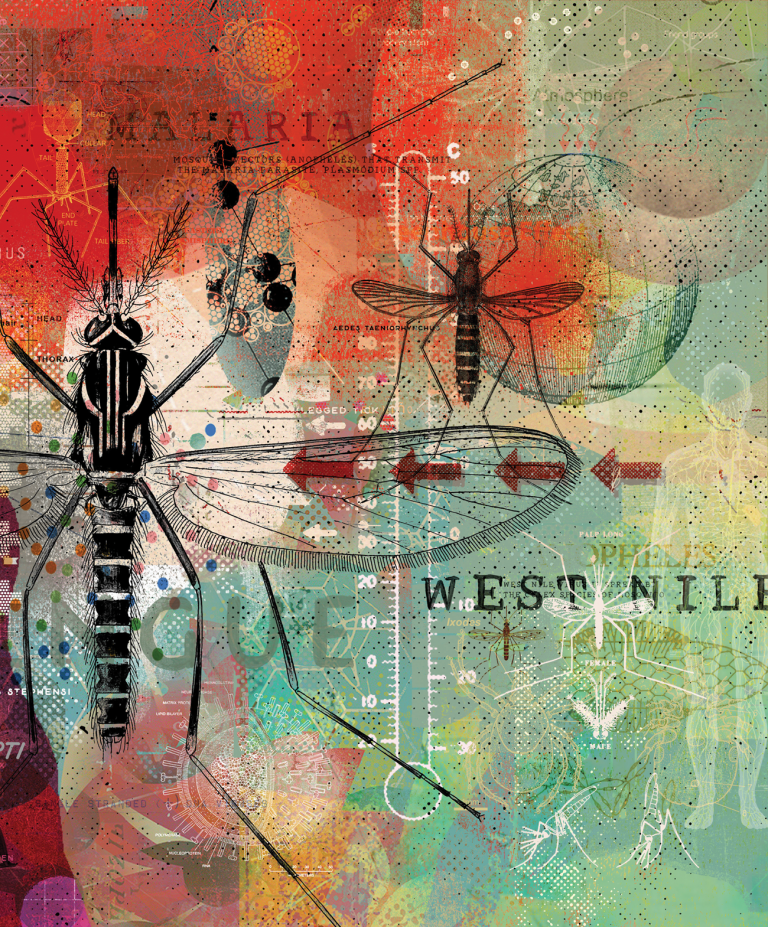Diseases Take Flight with Climate Change
The changing climate is providing opportunities for insects and other animals to spread infectious diseases to new populations
- 13 minute read
- Feature

In September 2018, Gaurab Basu received an email alerting him that one of his patients, a man in his late 60s, had just been hospitalized with unexplained fever and confusion. Basu, an HMS instructor in medicine, primary care physician, and co-director of the Center for Health Equity Education and Advocacy at Cambridge Health Alliance, suspected that his patient might have an infection, but the cause was unclear. “It took some real detective work to figure out what it was,” Basu says. A lumbar puncture finally pinpointed the source of his patient’s malaise: West Nile virus, a mosquito-borne pathogen more common to the tropics than New England in early autumn. Basu had never encountered the virus in any of his patients and says the diagnosis “came as a real surprise.”
All over the world, doctors like Basu are contending with the consequences of significant changes in the distribution and prevalence of vector-borne infectious diseases. West Nile fever surfaced in the United States in 1999 and has since become the country’s most common mosquito-borne illness, affecting thousands of people every year. The disease is also spreading into Europe, along with other mosquito-borne diseases such as dengue and chikungunya, while in Africa malaria is moving into higher elevations.
Tick-borne diseases are also on the move. Cases of Lyme disease, anaplasmosis, and Powassan encephalitis have more than doubled throughout the United States throughout the past two decades, as the ticks that transmit these illnesses expand into new areas, according to Ben Beard, deputy director of the Division of Vector-Borne Diseases at the U.S. Centers for Disease Control and Prevention in Fort Collins, Colorado.
Several factors explain these trends, not least among them demographic and land-use changes that bring people and infectious disease vectors closer together. “But many models suggest that temperature is a dominant driver,” says Jason Rohr, an infectious disease biologist and chair of the Department of Biological Sciences at the University of Notre Dame.
A disease that becomes more prevalent and severe in one place may become less so somewhere else and another may reveal a different temporal and geographic pattern.
Critical aspects of a vector’s lifecycle, such as its growth, reproductive capacity, and biting rates, are temperature dependent. Temperature also influences rainfall patterns that in turn affect vector habitats. In general, mosquitoes lay eggs in standing water, and ticks thrive in humid weather. For them, “drought is death,” says Sam Telford, professor of infectious disease and global health at the Cummings School of Veterinary Medicine at Tufts University.
As global mean temperatures rise steadily with climate change, efforts to model and predict future trajectories for vector-borne diseases are taking on a new urgency. Climate “profoundly influences the effectiveness of different kinds of health interventions,” says Matthew Bonds, an associate professor of global health and social medicine in the Blavatnik Institute at HMS. “By modeling the complex interactions of multiple hosts, viruses, and temperature, we seek to identify the most effective strategies for reducing the risk of disease emergence.”
Temperature creep
That climate contributes to the spread of infectious diseases has long been known. In ancient Rome, for example, aristocrats would retreat to hillside resorts in summer to avoid malaria, a disease whose name derives from the Latin mal + aria, or “bad air.”
Now climate change is affecting the infectious disease landscape in profound ways. Greenhouse gases resulting from the burning of fossil fuels have pushed mean global temperatures higher by just over 1°C since 1850. If the most recent projections from the United Nations Intergovernmental Panel on Climate Change (IPCC) hold true, global average temperatures could rise by more than 1.5°C over the next 20 years, leading to dramatically higher sea levels; longer and more frequent heat waves; and extreme weather events, which are unusually severe weather or climatic conditions that, according to the U.S. Department of Agriculture, devastate communities and agricultural and natural ecosystems.

According to the IPCC, each incremental increase in global temperatures will lead to more deaths from infectious diseases and other causes. Yet not all vector-borne diseases will respond in the same way, or uniformly, to increases in mean global temperatures, says David Relman, MD ’82, the Thomas C. and Joan M. Merigan Professor in Medicine and professor of microbiology and immunology at Stanford University. As the climate warms, “a disease that becomes more prevalent and severe in one place may become less so somewhere else and another may reveal a different temporal and geographic pattern,” he notes. In 2008, Relman was the chair of the National Academy of Sciences panel that examined how climate change and extreme weather could affect the emergence of infectious diseases.
Subscribe to Harvard Medicine magazine
Rohr agrees, adding that many scientists have abandoned what was once a basic assumption in infectious disease modeling, namely, that a vector’s performance, that is, its capacity to thrive and infect people, increases linearly with rising temperature. Current models, Rohr says, which capture nonlinear relationships between warming and performance better than previous models, show that transmission of disease increases with rising temperatures—up to a point. Excessive heat beyond what vectors and pathogens can tolerate can slow transmission “and then diseases begin to decline,” Rohr says.
Peter Hotez, dean for the National School of Tropical Medicine and professor of pediatrics and molecular virology and microbiology at Baylor College of Medicine, points out that in certain parts of east Africa, skyrocketing temperatures and diminishing rainfall patterns are adversely affecting the mosquitoes that carry malaria and the snails that carry schistosomiasis. Yet temperature increases at higher elevations may create new niches for vector-borne pathogens, further contributing to the redistribution of mosquito- and snail-borne diseases.
Rohr and his colleagues recently published modeling results showing that the transmission of West Nile and five other mosquito-borne viruses peaks between 23°C and 26°C before dropping off as temperatures increase. According to the model’s predictions, transmission seasons will lengthen where cooler areas get warmer and contract in areas where the current temperatures already bump up against the vectors’ thermal limits. The model also shows that warming can boost transmission in higher elevations, where cool temperatures ordinarily keep vector populations in check.
That is concerning especially for malaria transmission risk in the highlands of east Africa, which stretch over an area the size of Egypt south of the Sahara desert. Reaching heights of at least 1,500 meters, the highlands tend to be cool, with daily mean temperatures below 20°C. Malaria transmission occurs only seasonally in the region, and because of that, people who reside there are less likely to build an immunity to the disease than people in lower-lying areas where infections occur year-round.
With climate change, however, “I think malaria transmission in the highlands will increase,” says Marcia Castro, Andelot Professor of Demography and chair of the Department of Global Health and Population at the Harvard T.H. Chan School of Public Health. “Over time, those areas will become more susceptible to the mosquito vector staying longer than just a few months of the year.”
Predicting how warming affects malaria transmission is challenging, however, because climatic pressures often occur in tandem with land-use changes and health interventions that affect local disease rates. Indeed, deaths from malaria declined 40 percent in Africa between 2000 and 2015, largely because of the expanded use of insecticide-treated bed nets.
While a postdoc at the Harvard Chan School, Pamela Martinez, now an assistant professor of microbiology and statistics at the University of Illinois Urbana-Champaign and a visiting scientist at the Chan School, collaborated on a project to isolate the effects of temperature on the number of malaria cases in the highlands of Ethiopia. Malaria cases had surged in the highlands during the 1970s but by the beginning of the twenty-first century, the number of cases in the region had mysteriously fallen off. Martinez and her colleagues knew that efforts to protect local populations from infection had ramped up only in 2005, years after the incidence had begun trending downward. So public health interventions were not the likely reason for the decrease.
As it happened, however, the slowdown coincided with a multiyear pause in global warming between 1998 and 2005. During that time, mean global surface temperatures hardly budged, a phenomenon that scientists now attribute to transient and unusually strong oscillations in oceanic currents—El Niño in 1997-1998 and La Niña in 1998-1999—that led to the sea absorbing more heat from the atmosphere than normal.
Martinez and her colleagues suspected that the pause in global warming and the slowdown in malaria transmission were connected. Regional climate records confirmed that local temperatures had dropped in tandem with global averages during the period. When they modeled the data, the scientists found that climate conditions and the decrease in malaria cases were strongly coupled. Martinez says the findings underscore the crucial role of temperature in driving the incidence of malaria either lower or higher.
Warming also expands opportunities for disease transmission by other tropical pathogens, such as the Zika virus. Transmitted by the Aedes aegypti mosquito, the Zika virus had been common only in a narrow equatorial range in Africa and Asia. After 2007, however, the virus began spreading eastward across the Pacific Ocean. Since then, more than 80 countries have reported Zika outbreaks. An outbreak that began in Brazil in 2015 led to an estimated 1.5 million infections in that country before spreading elsewhere in the Americas. Zika typically produces mild symptoms, such as fever, rash, and muscle aches, but, in rare cases, patients can develop Guillain-Barré syndrome, a condition that drives immune cells to attack the nerves. Furthermore, infection with Zika during pregnancy can lead to debilitating birth defects, including microcephaly, in which the head and brain are abnormally small.

Bonds and his colleagues recently published a modeling study suggesting that in a worst-case scenario, 1.3 billion more people would live in temperature conditions suitable for Zika transmission by 2050. That scenario assumes that fossil fuels will be burned at ever-increasing rates. “It’s amazing how fast Zika takes off when temperatures are suitable for the mosquito vector,” says Bonds, who has doctoral degrees in ecology and economics. “Our models show it spreading like wildfire.” Bonds predicts that people living in most of the southern United States will over time face higher risks not only for infection by the Zika virus, but for infections by related flaviviruses in the same genus, including those that cause West Nile, dengue, and yellow fever.
Unwelcome uptick
Meanwhile, the incidence of diseases carried by an entirely different sort of vector—ticks—is exploding across the United States. According to Beard at the CDC, the number of cases of Lyme disease in the United States reported annually to the CDC recently approached 40,000. But busy doctors and public health workers often don’t have time to report Lyme disease cases, Beard says, so the real number is likely higher.
That likelihood seems feasible, based on case estimates from insurance claims data. The CDC estimates the average number of Lyme cases diagnosed and treated in the United States at 476,000 per year between 2010 and 2018, a substantial increase over the annual average of 329,000 cases documented in insurance claims between 2005 and 2010. The rise in numbers parallels corresponding increases in the geographical distribution of ticks that carry Lyme and other diseases. Tick populations are moving steadily north, and species appearing in different parts of the country are also changing.
“In the past twenty-five years,” says Beard, “the number of counties in which the blacklegged tick, which transmits the Lyme pathogen, Borrelia burgdorferi, has become established has more than doubled. The lone star tick, a vector for ehrlichiosis that was once limited largely to the southern United States, is now found all the way up into New England.”
Research indicates that many factors other than climate affect how ticks spread and come into contact with people. For instance, ticks prefer forest habitats, which in the United States have grown back following the steady decline in land cleared for agriculture since the 1800s. Thanks to conservation laws, white-tailed deer populations, which are reservoirs for ticks in the wild, have rebounded from about half a million in the early 1900s to more than 25 million today.
Human activities that influence disease risk are also changing. As suburban sprawl continues unabated, more people are spending time outdoors, where they face higher risk of infection. Beard agrees that climate change explains in part why ticks are spreading northward, but in other parts of the country, land use and human behavior play greater roles.
The human variable
Telford, who specializes in the ecology and epidemiology of tick-borne illnesses, also thinks humans play a significant role in disease risk. In a recent expert opinion in a book on climate, ticks, and disease published by CABI, an international organization dedicated to applying scientific expertise to problems affecting agriculture, Telford wrote that “human aspects of transmission risk are still poorly studied and need to be considered in any discussion of the role of climate change on vector-borne infections.” Cases of dengue fever in Mexico, he says, outnumber those in nearby parts of Texas “because Americans are more likely to have air-conditioning and stay inside, even though the mosquito habitat and breeding are identical on either side of the border.”
The math is a lot more complicated than simply putting in a climate variable and then assuming it’s going to lead to a doubling or tripling of cases of a disease like malaria.
Echoing points raised by Relman at Stanford, Telford speculates that climate change may not in fact generate net increases in vector-borne disease rates, assuming that rising cases in some areas are matched by declines in others. “You wind up with a shifting of the risk of disease,” Telford says. “The cases overall balance out.”
Still, social determinants and climate change can conspire to drive disease patterns in unexpected ways. Hotez cites a notable example: unprecedented temperatures of up to 50°C in the Middle East are fueling droughts that affect ancient agricultural lands, driving people to the cities, where crowding and urbanization, together with political instability, can lead to conditions that affect the rates of illness. In Aleppo, Syria, conflict has undermined infrastructure, resulting in, among other things, uncollected garbage that provides a breeding ground for sandflies that transmit a disfiguring illness called cutaneous leishmaniasis. The illness is becoming more widespread in the region.
Land-use changes can elevate disease risk by altering susceptibility to mosquito breeding, as shown by how deforestation in the Brazilian Amazon contributes to increases in malaria. Also, as new cities emerge in the Amazon, so do areas affected by dengue.
Learn more about the world of viruses
Castro does much of her field work in the Amazon, where her research focuses on mosquito-borne diseases. She says that climate change has the potential to expand areas suitable for the presence of mosquitoes and contribute to what she says are intensifying disease risks, which in many places are characterized by more frequent disease outbreaks.
“The math is a lot more complicated than simply putting in a climate variable and then assuming it’s going to lead to a doubling or tripling of cases of a disease like malaria,” Castro says. “When trying to simulate a future in which the climate is changing, you have to account for the underlying local context and epidemiology.”
Meanwhile, back in Massachusetts, Basu says clinicians need to be ready for surprising diagnoses and infectious diseases they might not otherwise expect to see. His West Nile patient eventually recovered but only after a long slog that took the better part of a year. “I tell my medical students that we need to keep monitoring and understanding the implications of global warming on our own practices. This is a dynamic process and things are changing.”
Charles Schmidt is a writer based in Maine.
Images: Dung Hoang (top, illustration); Jay Watson (Relman); John Soares (Castro)